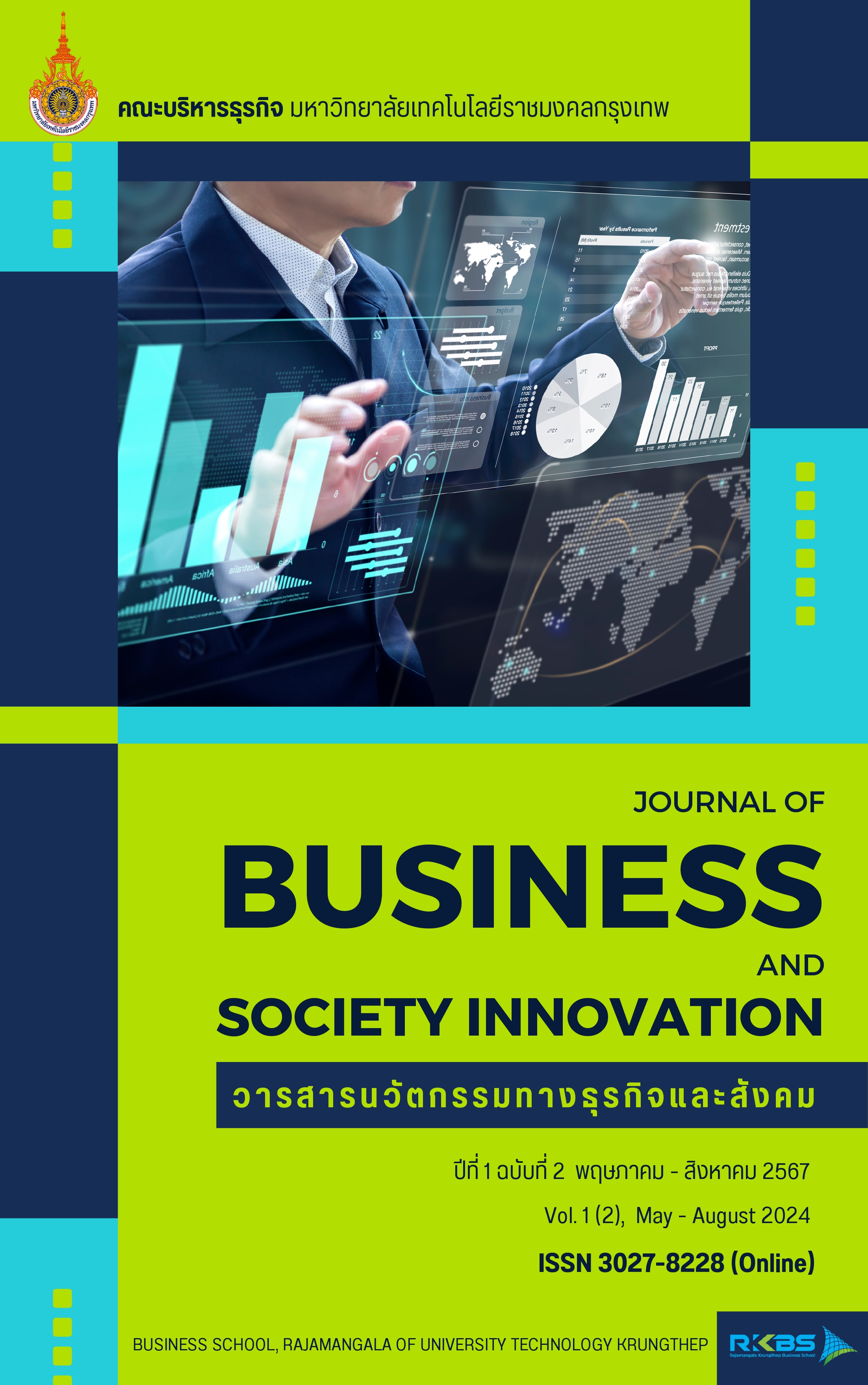การศึกษาความสัมพันธ์ระหว่างปัจจัยค้ำจุนและประสิทธิภาพการปฏิบัติงานของพนักงานในบริษัทการสื่อสารโทรคมนาคมในกรุงเทพมหานคร
คำสำคัญ:
ปัจจัยค้ำจุน, ประสิทธิภาพในการปฏิบัติงาน, บริษัทการสื่อสารโทรคมนาคมบทคัดย่อ
การวิจัยนี้มีวัตถุประสงค์ 1) เพื่อศึกษาระดับความคิดเห็นเกี่ยวกับปัจจัยค้ำจุนและประสิทธิภาพในการปฏิบัติงาน และ 2) เพื่อศึกษาความสัมพันธ์ระหว่างปัจจัยค้ำจุนและประสิทธิภาพในการปฏิบัติงานของพนักงานบริษัทการสื่อสารโทรคมนาคมในเขตกรุงเทพมหานคร กลุ่มตัวอย่างคือพนักงานจำนวน 298 คน เลือกโดยวิธีการสุ่มแบบเฉพาะเจาะจง เครื่องมือที่ใช้ในการวิจัยเป็นแบบสอบถามที่มีค่าดัชนีความสอดคล้อง (IOC) ระหว่าง 0.67-1.00 และค่าความเชื่อมั่นของแบบสอบถามทั้งฉบับเท่ากับ 0.91 วิเคราะห์ข้อมูลโดยใช้สถิติเชิงพรรณนาและสถิติสหสัมพันธ์แบบเพียร์สัน ผลการวิจัยพบว่า 1) พนักงานมีความคิดเห็นต่อปัจจัยค้ำจุนโดยรวมในระดับมากที่สุด (ค่าเฉลี่ย 4.53) โดยด้านความสัมพันธ์และการประสานงานระหว่างบุคคลมีค่าเฉลี่ยสูงสุด (4.72) ส่วนประสิทธิภาพในการปฏิบัติงานโดยรวมอยู่ในระดับมากที่สุด (ค่าเฉลี่ย 4.29) โดยด้านคุณภาพและมาตรฐานของผลงานมีค่าเฉลี่ยสูงสุด (4.59) 2) ปัจจัยค้ำจุนทุกด้านมีความสัมพันธ์เชิงบวกกับประสิทธิภาพในการปฏิบัติงานอย่างมีนัยสำคัญทางสถิติ โดยการบริหารและการสนับสนุนของผู้บังคับบัญชามีความสัมพันธ์สูงสุด (r = 0.68) ผลการวิจัยนี้สามารถนำไปใช้ในการพัฒนากลยุทธ์การบริหารทรัพยากรมนุษย์เพื่อเพิ่มประสิทธิภาพการปฏิบัติงานของพนักงานในอุตสาหกรรมโทรคมนาคมต่อไป
References
ณัฐพล ชวนสมสุข, วิโรจน์ เจษฎาลักษณ์, และ จันทนา แสนสุข. (2564). ปัจจัยที่ส่งผลต่อประสิทธิภาพในการปฏิบัติงานของพนักงานในอุตสาหกรรมการผลิตชิ้นส่วนยานยนต์. วารสารมหาจุฬานาครทรรศน์, 8(1), 183-198.
ธงชัย สันติวงษ์. (2542). การบริหารงานบุคคล. กรุงเทพฯ: ไทยวัฒนาพานิช.
ธนัชพร กบิลฤทธิวัฒน์. (2565). ปัจจัยที่ส่งผลต่อประสิทธิภาพในการปฏิบัติงานของพนักงานบริษัทเอกชนในเขตกรุงเทพมหานคร. วารสารวิชาการมหาวิทยาลัยธนบุรี, 16(2), 71-82.
พิชญา วัฒนรังสรรค์. (2564). การบริหารทรัพยากรมนุษย์ในยุคดิจิทัล: กรณีศึกษาอุตสาหกรรมโทรคมนาคมไทย. วารสารบริหารธุรกิจและสังคมศาสตร์ มหาวิทยาลัยรามคำแหง, 4(2), 86-101.
รัตนา แสงจันทร์. (2565). ปัจจัยที่ส่งผลต่อประสิทธิภาพการทำงานของพนักงานในอุตสาหกรรมเทคโนโลยีสารสนเทศและการสื่อสาร. วารสารวิชาการบริหารธุรกิจ สมาคมสถาบันอุดมศึกษาเอกชนแห่งประเทศไทย, 11(1), 161-176.
วิลาวัลย์ จันทร์ศรี. (2564). ปัจจัยที่ส่งผลต่อประสิทธิภาพในการปฏิบัติงานของพนักงานในอุตสาหกรรมการผลิตจังหวัดปทุมธานี. วารสารวิชาการมหาวิทยาลัยกรุงเทพธนบุรี, 10(1), 104-115.
ศศิมา อุดมศิลป์. (2564). อิทธิพลของปัจจัยค้ำจุนที่มีต่อประสิทธิภาพในการปฏิบัติงานของพนักงานบริษัทโทรคมนาคมแห่งหนึ่งในกรุงเทพมหานคร. วารสารบริหารธุรกิจและสังคมศาสตร์ มหาวิทยาลัยรามคำแหง, 4(3), 126-141.
สมยศ นาวีการ. (2540). การบริหารและพฤติกรรมองค์การ. กรุงเทพฯ: ผู้จัดการ.
สุพิชญา วงศ์วาสนา. (2564). ปัจจัยที่ส่งผลต่อประสิทธิภาพในการปฏิบัติงานของพนักงานบริษัทในอุตสาหกรรมอิเล็กทรอนิกส์. วารสารวิชาการมหาวิทยาลัยราชภัฏนครปฐม, 13(1), 238-250.
สุภาวดี ขุนทองจันทร์. (2565). ปัจจัยที่ส่งผลต่อประสิทธิภาพในการปฏิบัติงานของบุคลากรในยุคดิจิทัล. วารสารวิชาการมหาวิทยาลัยราชภัฏเพชรบุรี, 12(1), 127-137.
Alshmemri, M., Shahwan-Akl, L., & Maude, P. (2017). Herzberg's two-factor theory. Life Science Journal, 14(5), 12-16.
Bethlehem, J. (2009). Applied survey methods: A statistical perspective. Hoboken, NJ: John Wiley & Sons.
Cohen, J., Cohen, P., West, S. G., & Aiken, L. S. (2013). Applied multiple regression/correlation analysis for the behavioral sciences (3rd ed.). New York: Routledge.
Creswell, J. W., & Creswell, J. D. (2018). Research design: Qualitative, quantitative, and mixed methods approaches (5th ed.). Thousand Oaks, CA: Sage Publications.
Cronbach, L. J. (1951). Coefficient alpha and the internal structure of tests. Psychometrika, 16(3), 297-334.
Dillman, D. A., Smyth, J. D., & Christian, L. M. (2014). Internet, phone, mail, and mixed-mode surveys: The tailored design method (4th ed.). Hoboken, NJ: John Wiley & Sons.
Etikan, I., Musa, S. A., & Alkassim, R. S. (2016). Comparison of convenience sampling and purposive sampling. American Journal of Theoretical and Applied Statistics, 5(1), 1-4.
Field, A. (2018). Discovering statistics using IBM SPSS statistics (5th ed.). London: Sage Publications.
Fowler, F. J. (2014). Survey research methods (5th ed.). Thousand Oaks, CA: Sage Publications.
Gantt, H. L., & Clark, W. (1923). The Gantt chart, a working tool of management. New York: Ronald Press.
Ismail, A., Nowalid, W. A. W. M., & Bakar, R. A. (2021). Effect of compensation on job performance in Malaysian telecommunication industry. International Journal of Business and Society, 22(1), 247-266.
Israel, M., & Hay, I. (2006). Research ethics for social scientists. London: Sage Publications.
Likert, R. (1932). A technique for the measurement of attitudes. Archives of Psychology, 22(140), 5-55.
Nguyen, T. H., Pham, T. L., & Nguyen, T. H. (2022). Factors affecting employee performance: A case of Vietnam's telecommunications industry. Journal of Asian Finance, Economics and Business, 9(3), 409-419.
Nunnally, J. C., & Bernstein, I. H. (1994). Psychometric theory (3rd ed.). New York: McGraw-Hill.
Pham, L. T. M., Tran, H. T., Pham, T. T., & Nguyen, H. T. (2020). Factors influencing employee performance: An empirical study in Vietnam's telecommunications industry. Journal of Asian Finance, Economics and Business, 7(11), 977-986.
Putri, E. M., Ekowati, V. M., Supriyanto, A. S., & Mukaffi, Z. (2021). The effect of work environment on employee performance mediated by work motivation. Journal of Asian Finance, Economics and Business, 6(2), 615-624.
Rovinelli, R. J., & Hambleton, R. K. (1977). On the use of content specialists in the assessment of criterion-referenced test item validity. Dutch Journal of Educational Research, 2, 49-60.
Tabachnick, B. G., & Fidell, L. S. (2019). Using multivariate statistics (7th ed.). Boston: Pearson.
Tongco, M. D. C. (2007). Purposive sampling as a tool for informant selection. Ethnobotany Research and Applications, 5, 147-158.
Turner, J. R. (2014). The handbook of project-based management: Leading strategic change in organizations (4th ed.). New York: McGraw-Hill Education.
Yamane, T. (1967). Statistics: An introductory analysis (2nd ed.). New York: Harper and Row.
Downloads
เผยแพร่แล้ว
How to Cite
ฉบับ
บท
License
Copyright (c) 2024 วารสารนวัตกรรมทางธุรกิจและสังคม

This work is licensed under a Creative Commons Attribution-NonCommercial-NoDerivatives 4.0 International License.

